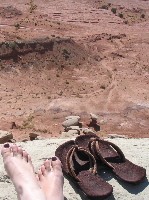Galaxies, background
I've finally arrived in Ishigaki. There is time set aside for a poster session today, and since I got bored on the plane yesterday and already wrote this up, I think I'll just give you some background on the research I've spent the last 9 months doing. Results to come later! The paper is at astro-ph/0606460.
First, a bit of background. To fully appreciate this project, you have to understand that galaxies are cool. Like, sexy cool. Like, really really pretty. Specifically, spiral galaxies are just to die for. Just look at any of the pictures I have here and you'll understand what I mean. One reason galaxies are so awesome is that they have a lot of stuff in them: stars, large groups of stars (called star clusters), gas (like H2, CO, etc.), and dust (tiny grains of stuff, like dust on Earth, but without all of the dead skin cells). There is a lot more gas than dust, but usually where there is dust, there is gas, and as dust absorbs and scatters more light than the gas, it is easier to observe where the dust is and infer that there's a bunch of gas there as well. It's interesting to know where the gas is because if you get a bunch of gas into a small region, then stars begin to form. Oh, and it's pretty.
Now that that's out of the way, you should also know that most galaxies are barred. This means that instead of just a mess of spiral arms, there is some straight feature in the middle, such as is seen in NGC1300 or NGC1530. Bars are believed to funnel gas and dust from the outer regions of galaxies to the centers. It has been observed that, in general, barred galaxies have a higher concentration of gas at their centers than unbarred galaxies do, which is a bit of evidence that the bar is responsible for transporting the gas to the center. What we tried to investigate in this project is exactly what happens to the structure or morphology of the gas (or, more specifically, the dust) when it gets near the center.
We made these things called "structure maps" in order to look at where the dust is (all of the grayscale images in the paper and on the poster are structure maps). The dark regions are due to dust, while the bright regions are due to emission (which usually indicates star formation). These were made from archival HST (Hubble Space Telescope) data. HST is really good about making data publicly available after a short time; anyone can easily search their archive and download the data. There were a few papers published which had measured barstrengths for a bunch of nearby galaxies, and using this list I searched for which galaxies have available HST data including the galaxy center. I then downloaded these, ran some code on the files, and created the structure maps.
Once all of the structure maps were made, we finally got to look at all of the galaxies. We classified the central regions into six different categories. It's been known for a while that spiral galaxies often have nuclear spirals. Large-scale spirals are usually made of young, blue stars, and are essentially the size of the galaxy---on the scale of ten parsecs, say. (One parsec is the distance at which one AU (the distance from the Earth to the Sun) subtends one arcsecond on the sky. It's a little over 3 lightyears.) Nuclear spirals are completely distinct from these large-scale spirals; they are regions of slightly higher gas and dust density, are typically less than one kiloparsec in size. Our nuclear morphology classification scheme has four categories for nuclear spirals: grand design (GD), loosely wound (LW), tightly wound (TW), and chaotic spiral (CS). The grand design class is based on large-scale grand design spirals: there are two prominent symmetric arms which, for our definition, are seen to extend into the galaxy nucleus. This is an interesting class because it has been observed (and theorized) that GD structure should be found primarily in barred galaxies; dust lanes along the bar are seen to spiral towards the nucleus once they reach the central regions. LW and TW spirals are basically just coherent spirals, but the tightly wound ones are, well, more tightly wound. (The prototypes figure has a good visual example of the difference between these two classes.) How tight the spiral is can tell us a lot about the environment in which the spiral was formed and exists. Chaotic spirals are nuclear spirals that, while still having a unique sense of chirality, are relatively incoherent. The other two classes, chaotic (C) and no structure (N) are for nuclear regions with no clearly discernible spiral structure.


1 comment:
What I knew before I read this was mostly that they're pretty. I know more now, so you can congratulate yourself on being clear.
Post a Comment